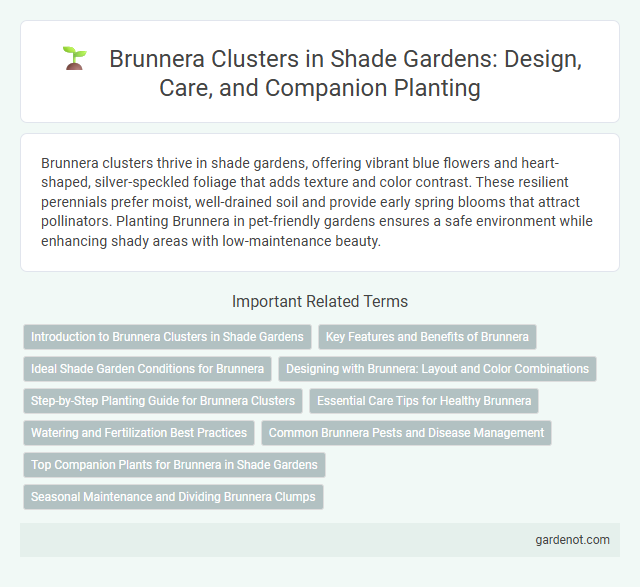Brunnera clusters thrive in shade gardens, offering vibrant blue flowers and heart-shaped, silver-speckled foliage that adds texture and color contrast. These resilient perennials prefer moist, well-drained soil and provide early spring blooms that attract pollinators. Planting Brunnera in pet-friendly gardens ensures a safe environment while enhancing shady areas with low-maintenance beauty.
Introduction to Brunnera Clusters in Shade Gardens
Brunnera clusters thrive in shady garden environments, offering lush, heart-shaped leaves and delicate, azure-blue spring flowers that brighten shaded areas. These perennials prefer moist, well-drained soil and partial to full shade, making them ideal for under trees or alongside shade-loving plants. Their low maintenance and striking foliage create a vibrant textural contrast in shade gardens throughout the growing season.
Key Features and Benefits of Brunnera
Brunnera clusters feature heart-shaped, blue-green leaves with delicate, sky-blue flowers that bloom in early spring, adding vibrant color to shade gardens. Their shade tolerance and low maintenance make them ideal for under trees and shaded borders, while their deer-resistant properties ensure longevity in wildlife-prone areas. Brunnera enhances garden biodiversity by providing early nectar sources for pollinators, contributing to a healthy ecosystem.
Ideal Shade Garden Conditions for Brunnera
Brunnera thrives in moist, well-drained soil rich in organic matter, making it ideal for shade gardens with consistently damp conditions. This shade-loving perennial prefers partial to full shade, protecting its heart-shaped, silver-speckled leaves from harsh sunlight that can cause leaf scorch. Optimal temperatures range from cool to moderate, ensuring vibrant foliage and delicate blue flowers during spring in temperate climates.
Designing with Brunnera: Layout and Color Combinations
Designing with Brunnera in shade gardens involves creating lush clusters that highlight its heart-shaped, silver-speckled leaves and delicate blue forget-me-not flowers. Pair Brunnera with hostas, ferns, and astilbes to enhance texture contrast and maintain a cool color palette of greens, blues, and purples. Strategic placement along shaded pathways or borders boosts visual interest while ensuring optimal growth in moist, well-drained soil.
Step-by-Step Planting Guide for Brunnera Clusters
Select a partially shaded location with rich, well-draining soil to plant Brunnera clusters for optimal growth. Space each crown about 12 to 18 inches apart, dig holes twice the width of the root ball, and plant at the same soil level as in the nursery pot. Water thoroughly after planting and mulch to retain moisture, ensuring consistent hydration during the establishment period.
Essential Care Tips for Healthy Brunnera
Brunnera thrives in moist, well-drained soil with consistent watering to prevent leaf wilt and promote vigorous growth. Partial to full shade exposure protects the plant from harsh sunlight, maintaining vibrant foliage and preventing leaf scorch. Regular mulching and occasional feeding with a balanced fertilizer support healthy root development and abundant blooms in spring.
Watering and Fertilization Best Practices
Brunnera clusters thrive in consistently moist, well-drained soil, requiring regular watering to prevent drought stress without causing waterlogging. Water deeply once or twice a week, increasing frequency during dry spells, to maintain optimal hydration levels. Apply a balanced, slow-release fertilizer in early spring to promote healthy growth and vibrant foliage throughout the growing season.
Common Brunnera Pests and Disease Management
Common Brunnera pests include aphids, slugs, and spider mites, which can cause leaf discoloration and damage. Disease management focuses on preventing powdery mildew and leaf spot by ensuring proper air circulation and avoiding overhead watering. Regular monitoring and timely application of insecticidal soap or fungicides help maintain a healthy Brunnera cluster in shade gardens.
Top Companion Plants for Brunnera in Shade Gardens
Brunnera thrives in shade gardens when paired with hostas, ferns, and astilbes, which complement its heart-shaped foliage and blue flowers. Ferns, such as the Japanese painted fern, enhance texture contrast, while astilbes introduce vibrant plume flowers that brighten shady areas. These companion plants share similar moisture and soil preferences, ensuring harmonious growth in shaded environments.
Seasonal Maintenance and Dividing Brunnera Clumps
Brunnera clusters require seasonal maintenance that includes removing spent blooms and cutting back foliage in late fall to prevent disease and encourage healthy regrowth. Dividing Brunnera clumps is best done in early spring or late summer when the plant is dormant or less active, ensuring minimal shock and improved vitality. Proper division promotes vigorous growth and helps control the spread of this shade-loving perennial.
Brunnera cluster Infographic

 gardenot.com
gardenot.com